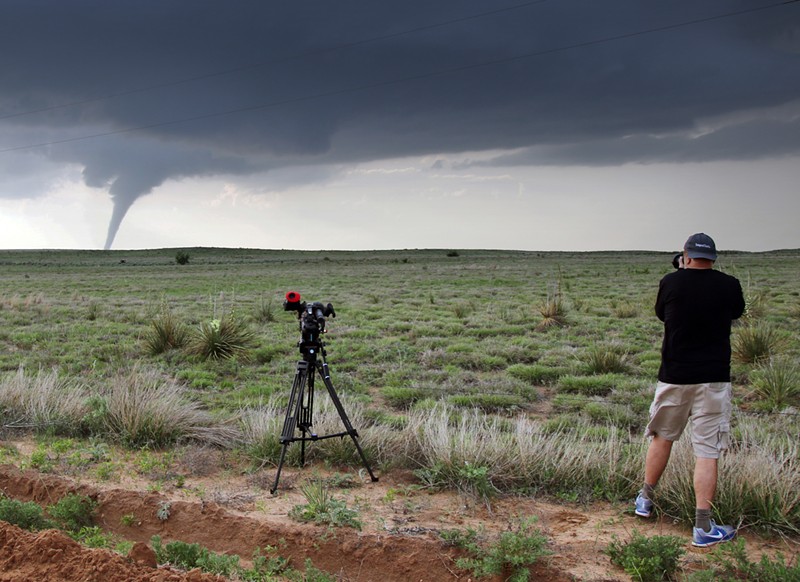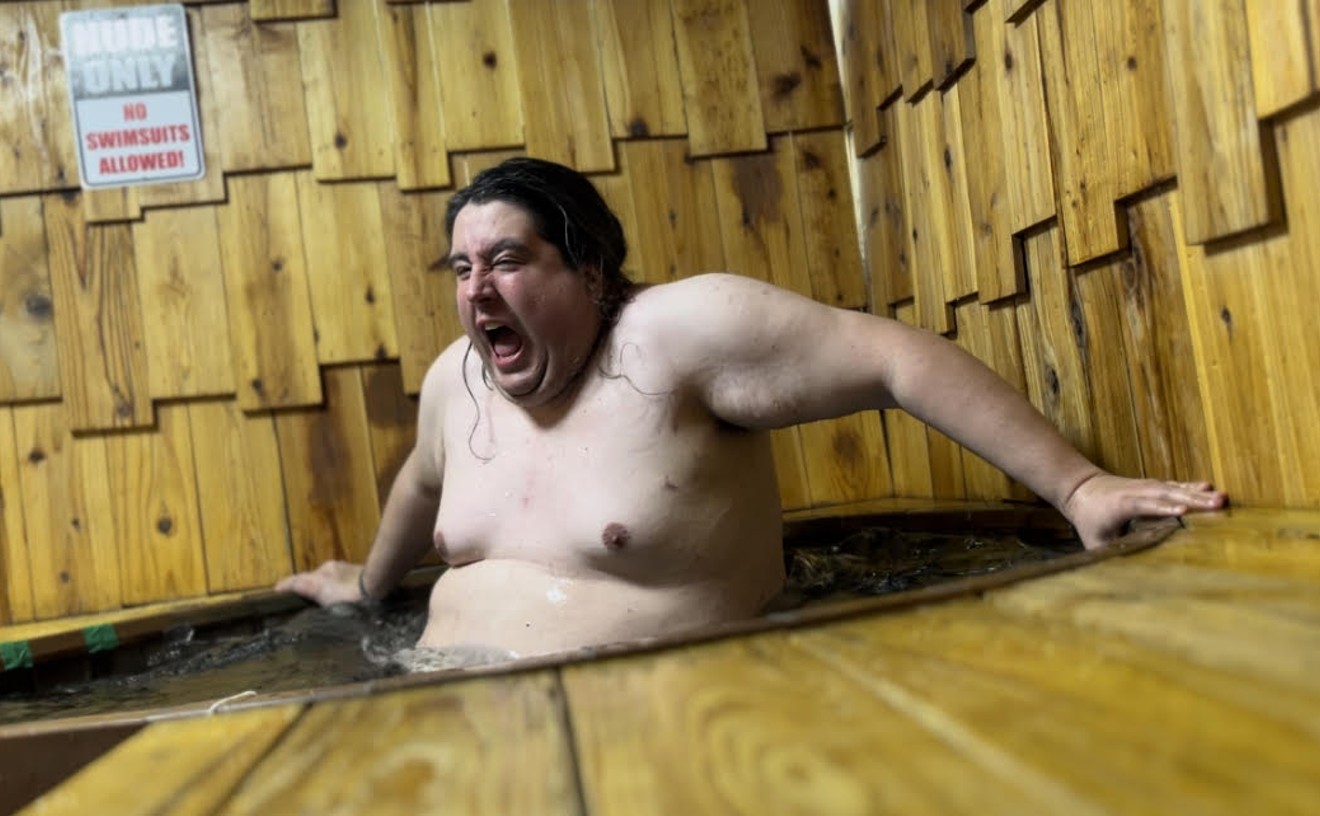Born and raised in Texas — reportedly the most disaster-prone state in the U.S. according to a 2022 FEMA report — Martin is an innovator in the storm chasing community. Storm chasing lead him to work as a filmmaker, teacher, entrepreneur and creator.
His passion for the weather began at age 12. In recent years, he has launched multiple extreme weather-related businesses, including StormStock, a licensed climate footage company; Texas Severe Storms Association, a nonprofit group that brings enthusiasts together to provide information to the public; and Tempest Tours, a company that takes guests on storm-chasing expeditions.
The expeditions have become highly lucrative. As Lisuis' popularity grew, people constantly asked to join his storm-chasing ventures, creating a demand he couldn't pass up on.
“Tempest Tours was not created to make money,” he says. “It wasn't created to monetize chasing. I created it because people kept asking me to go storm chasing and they couldn't go. I'd say, ‘Hey, can you go tomorrow?’ ‘I can't go. I have to work.’ And I go, ‘Oh, OK’ After that happened many times, then I said, ‘You know what? We just need to make a little tour company, publish the schedule six months in advance or whatever. People can sign up and they can pay us a fee for it. It evolved because of the need of people wanting to go storm chasing.”
Lisius credits Tempest Tours' success to the professionalism of his staff.
“That's a big part of the success,” he says. "We operate it like a business. Everyone who works for us is a professional. Our guys in the field, our senior tour directors and the forecasters are top-notch — the best in the country.”
Tempest Tours isn't just about Lisius. Several of his staff members, such as famous storm-chaser Kim George, have their own fan bases. George's presence at the movie premiere was enthusiastically embraced by fans. National Geographic, The Wall Street Journal, the BBC and others have profiled her.
“We're the only storm chasing tour company listed with the National Tourist Association, because you can only be listed with them if you have general liability insurance,” George says.
Surrounded by a like-minded group, Martin Lisius still enjoys chasing storms.
“I really liked storm chasing,” he says. “I really liked storms. I like being around the people that I work with. They're just fun, and they're kind of goofy, and I like them, and they're smart.”
Lisius became a consultant for Twister in 1996 because of his expertise and popularity. A film consultant guides the production of a film. He has consulted on 29 weather-related motion pictures.
Twisters, starring Glenn Powell (Top Gun: Maverick) and Daisy Edgar-Jones (Under the Banner of Heaven), is a reboot of the 1996 original. In it, a group of ambitious storm chasers tracks various natural disasters to test a new weather system. The film’s soundtrack features new music by North Texas’ Leon Bridges and Charley Crockett.
At the Fort Worth premiere, Lisius enjoyed the final version of the film, pointing out Easter eggs to other storm chasers and even monitoring tricks used in the movie that he has applied to his chases.
“I still do that sometimes,” Lisius remembers saying while watching Kate (played by Edgar-Jones) pick up a dandelion to determine the storm's direction.
While he enjoyed watching the tricks of the trade, Lisius is quick to debunk the film's exaggerated tornadoes and gadgets. For instance, he says, no "Dorothy" machine ever detected F5 tornados from the original movie; Hollywood made it up.
“There's these things that go up in a tornado, we spin around and then has a graphic that makes a tornado picture," he says. "OK, so we know that it spins now that we had this probe, but we kind of knew that already. Just by looking at the tornado, you can see it spinning. So usually Hollywood, if you watch the Hollywood depiction of storm chasing, they usually have a mission and it's usually to deploy some kind of probe or something, but the probe doesn't make any sense. It doesn't do anything whatsoever in terms of research.”
Storm chasing involves traveling to locations where severe weather is forecasted. Although it can be hazardous, its popularity has grown enormously due to its potential as social media content.
“In '96, there might've been maybe five chase cars in my area on a storm," Lisius says. "And then several chases with no visible storm chasers. And then today, it's rare not to have at least some storm chasers visible. One day in May, I was chasing a storm up by Bowie and it had a tornado warning on it for about an hour and a half. When a storm has a tornado warning for a very long time, it picks up more chasers.
“They hear about it, and they go out and try to chase it. So by the time I was about to cross the Red River in Oklahoma, I turned on the highway. I looked down the highway, and there was a line of chasers, maybe 30 cars long, eastbound on the road track going after the storm. It looked like you were in a city, but it wasn't the city at all. It was a very rural area. So that's what we see now.”
According to Lisius, what was once a small community has grown into a mass phenomenon of thrill seekers. Those chasing a viral moment have made the activity even more dangerous.
“The problem is driving. It's not the tornado; it's driving. And that affects everybody," he says. "If they want to drive into a tornado and kill themselves, then that's not going to hurt anybody else except whoever's with them. So they're not going to hurt the people around them, the community. But when they start driving dangerously, then it can hurt people. Just farmers or whatever, whoever's out there, or other chasers. And really, the vast majority of chasers that have been killed are killed in car accidents.”
Until recently, Lisius can’t recall deaths while chasing.
“I don't know of any fatalities until maybe, I don't know, maybe 2010, 2005,” he says. “Somewhere in there, I think we started seeing some fatalities. But prior to that, I don't recall any fatalities at all. And I think that's just because of the numbers."
In 25 years, Lisius has captured everything from the most beautiful moments to the most devastating — Hurricane Katrina in 2005 being the worst.
“As the hurricanes I've chased, it was definitely the most difficult,” he says. “We had some challenges that I hadn't seen in other hurricanes. The guy that I was with was not a chaser. He was an ATV producer. And he was scared. He would normally be a really funny guy.”
Hurricane Katrina was one of the worst natural disasters in history, when 80% of New Orleans became submerged, resulting in 1,390 deaths.
“There were probably around 300 to 400 people that died within miles of us, but they were in the wrong place,” Lisius remembers. “They were down by the water. The storm surge came in. World record storms are 35 feet. It had never recorded in the history of the world... Well, I mean during modern human times. And so anything that was within maybe eight blocks of the ocean was completely leveled. And that's where all those people were that died. And we were half a mile further inland, but we weren't down in that stuff. I approached from the North, from inland, going towards the sea and just going as far as I could go safely. And then we filmed what we could see, which was pretty dramatic.”
Twisters filmed in North Texas and Oklahoma. After consulting the original, Tempest Tours' signature van appears in the new movie, for which he also consulted. The revamp's entertaining over-the-top theatrics align with Lisius' own powerful documentary.
In celebration of StormStock’s 30th anniversary, Lisius released the new documentary The Chasers of Tornado Alley: Touching the Sky on Prairie Pictures. Two dozen of America's best storm chasers gathered for the film, which has been praised as one of the most accurate storm-chasing documentaries ever made. The groundbreaking film won “Best Cinematography” at the Reale Film Festival in Milan. Twisters exceeded expectations with an $80 million opening week at the box office. With new storm-chasers being born, Martin Lisius and Tempest Tours have a bright future.
The Tempest Tours schedule for 2025 has sold out, and a waitlist is open for expeditions in 2026. Visit Tempest Tours' website to learn about storm chasing and its schedule. The Chasers of Tornado Alley: Touching The Sky is now on Vimeo.












